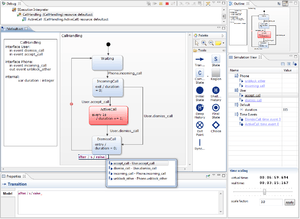YAKINDU Statechart Tools
 | |
 | |
| Initial release | 2008 |
|---|---|
| Stable release |
2.9.0
/ 2016-11-28 |
| Platform | Eclipse / Java |
| Licence | Eclipse Public License |
| Website | www.statecharts.org |
YAKINDU Statechart Tools (SCT) is an open-source tool[1] for the specification and development of reactive, event-driven systems with the help of finite-state machines. It consists of an easy-to-use tool for the graphical editing of statecharts and provides validation, simulation and code generators for various target platforms. Users are coming from both industry[2] and academia.[3][4][5][6]
Concepts
YAKINDU Statechart Tools implement the concept of statecharts as invented by David Harel in 1984.[7] Statecharts have been adopted by the UML later.[8]
The software can be used to model finite-state machines. Important theoretical models for finite-state machines are Mealy machines and Moore machines. YAKINDU Statechart Tools can be used to model both these types.
Functionality
The main features of YAKINDU Statechart Tools are:
- smart combination of textual and graphical modeling
- syntactic and semantic validation of the state machines
- executable models via the simulation engine
- code generators for Java, C and C++
Extensibility
YAKINDU Statechart Tools provide open APIs, allowing for adaptions to specific requirements to a large extend. Not only are the code generators expandable; the developer can also specify his own statechart dialect. For this purpose the concept of domain-specific statecharts is defined. This makes it possible to use statecharts as reusable language modules.
History
The first version of YAKINDU Statechart Tools was released in 2008 as part of the research project MDA for Embedded.[9] In this research project, model-based development processes for the development of embedded systems based on the Eclipse project were developed. Since mid-2010 the YAKINDU team, consisting mainly of employees of itemis AG, a company in Lünen, Germany, has been working on Version 2.0. The first official version was released together with Eclipse version Juno. The current SCT version 2.7 is compatible to Eclipse versions 4.5 (Mars) and 4.6 (Neon).
Award
- Germany – Land of Ideas 2008: Model-based generative software development for embedded systems[10]
Literature and Sources
- Mülder, Andreas; Nyßen, Alexander (2011). "TMF meets GMF". Eclipse Magazin (in German). Frankfurt am Main: Software & Support Media GmbH (Nr. 3): S. 74–78. ISSN 1861-2296. Archived from the original (PDF) on 2016-06-20. Retrieved 2016-06-20.
- Mülder, Andreas; Unger, Andreas (2012). "Yakindu ist auch eine Stadt". Eclipse Magazin (in German). Frankfurt am Main: Software & Support Media GmbH (Nr. 3). ISSN 1861-2296.
- Alexander Nyßen (2011). "TMF meets GMF – Combining Graphical & Textual Modeling". EclipseCon Europe 2011. Archived from the original (PDF) on 2016-06-17. Retrieved 2016-06-17.
- Nyßen, Alexander; Terfloth, Axel (2012). "YAKINDU SCT – Domain-Specific Statecharts". EclipseCon 2012. Archived from the original on 2012-09-15. Retrieved 2012-09-15.
- Terfloth, Axel (2011-07-12). "Modellgetriebene Entwicklung mit der Yakindu Workbench: Vortrag auf dem BAIKEM Netzwerktreffen Embedded Systems" (in German). Bayern Innovativ. Archived from the original (PDF) on 2016-09-15. Retrieved 2016-09-15.
External links
References
- ↑ Neumann, Alexander (2009-03-05). "itemis stellt Statechart-Tools unter die Eclipse-Lizenz". Heise Developer (in German). Archived from the original on 2016-06-17. Retrieved 2016-06-17.
- ↑ "Improved AUTOSAR tool chain with YAKINDU – Case Study: Leopold Kostal GmbH & Co. KG". itemis AG. Archived from the original on 2016-09-15. Retrieved 2016-09-15.
- ↑ Christian Motika (2014-06-27). "SCCharts-Editor based on Yakindu". Christian-Albrechts-Universität zu Kiel. Archived from the original on 2016-09-14. Retrieved 2016-09-14.
- ↑ Erik Kamsties, Burkhard Igel (2011-03-16). "Vorlesung "Einführung in die modellbasierte Softwareentwicklung"" (in German). Fachhochschule Dortmund. Archived from the original on 2016-09-14. Retrieved 2016-09-14.
- ↑ Mohamad Sbeiti. "Simulation-based Performance Evaluation of PASER". Technische Universität Dortmund. Archived from the original on 2012-12-17. Retrieved 2012-07-05.
- ↑ A. Topalidou-Kyniazopoulou, N. I. Spanoudakis2, M. G. Lagoudakis (2012-03-04). "A CASE Tool for Robot Behavior Development". Technical University of Crete. Archived from the original (PDF, 762 kB) on 2016-09-14. Retrieved 2016-09-14.
- ↑ Harel, David (1984). "Statecharts: A Visual Formalism For Complex Systems". Science of Computer Programming. North Holland. 8: 231–274. Archived from the original (PDF) on 2016-06-17.
- ↑ OMG (February 2009). "OMG Unified Modeling Language (OMG UML), Superstructure Version 2.2". p. 525.
- ↑ "Tutorial: Statechart Editor mit GMF erstellen". Forschungsprojekt MDA for Embedded (in German). itemis AG, Ingenieurbüro Dr. Kahlert, Nachrichtentechnik FH Dortmund. 2008-07-16. Archived from the original on 2016-06-17.
- ↑ "365 Orte: Lünen 2008". Deutschland – Land der Ideen (in German). Deutschland – Land der Ideen Management GmbH. 2009-03-05. Archived from the original on 2016-06-17. Retrieved 2016-06-17.